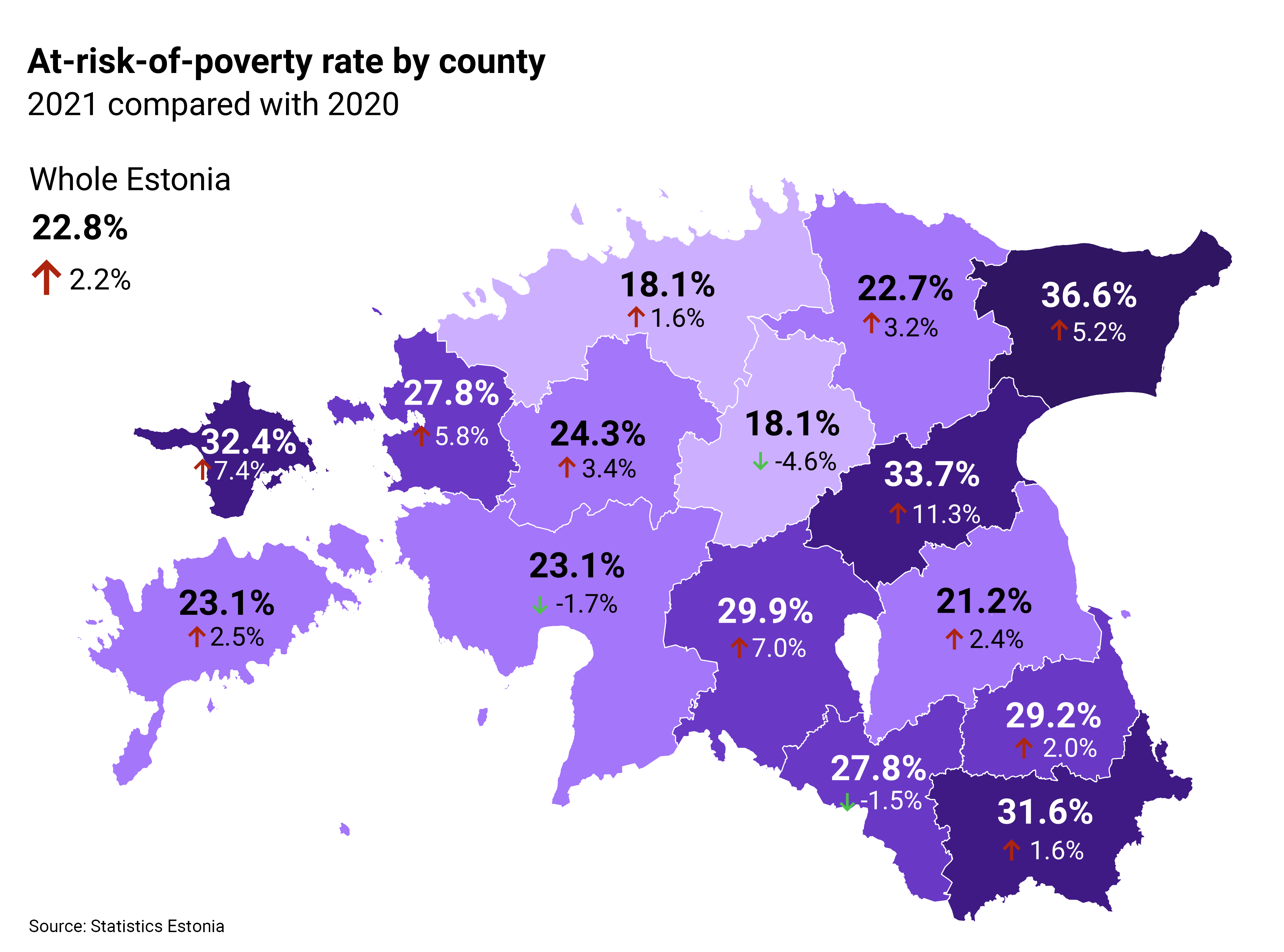At-risk-of-poverty rate is highest among the elderly, while among families with children it is highest for single parents (corrected on 09.12.2022)
According to Statistics Estonia, 22.8% of Estonia’s population lived at risk of poverty and 1.4% in absolute poverty in 2021. Compared with 2020, the share of people living at risk of poverty rose 2.2% and the share of people living in absolute poverty fell 0.8%.
The sentences marked in red, the first graph and the county map were corrected in the news release.
Anet Müürsoo, Head of Population and Social Statistics Department of Statistics Estonia, says that the at-risk-of-poverty rate reflects income inequality in a country. “Close to 301,100 people lived at risk of poverty in 2021, which is nearly 30,300 persons more than in 2020. Their monthly income, taking into account household composition, was less than 763 euros,” said Müürsoo.
The at-risk-of-poverty rate was the highest in years and increased mainly among the elderly, while it decreased among families with children. “Of people aged 65 and over living alone, 81.7% were at risk of poverty, up 3.6% from the year before. This is largely due to the size of the average old-age pension, which is below the at-risk-of-poverty threshold. We also see that almost one in three lone parents live at risk of poverty. Their incomes have not increased as fast as, for example, those of two-parent families,” explained Müürsoo.
The at-risk-of-poverty rate was highest in Ida-Viru (36.6%), Jõgeva (33.7%), and Hiiu (32.4%) counties. It was lowest in Harju (18.1%), Järva (18.1%), and Tartu (21.2%) counties. The at-risk-of-poverty rate increased the most in Jõgeva (11.3%), Hiiu (7.4 %), and Viljandi (7.0%) counties. The biggest drop was recorded in Järva (4.6%), Pärnu (1.7%), and Valga (1.5%), counties.
Absolute poverty indicates the share of the population who are not able to meet their basic needs. “In 2021, nearly 18,000 people lived in absolute poverty – 10,700 fewer than the year before. The monthly income of people living in absolute poverty, taking into account household composition, was less than 234 euros,” noted Müürsoo.
The absolute poverty rate was highest among people aged under 65 living alone (5.5%). By age group, absolute poverty was highest among 18–24-year-olds (2.6%).
In 2022, the share of people living in deprivation, i.e. people who cannot afford various items commonly available in the society, was slightly larger than in the previous year – 7% of Estonia’s population, or 92,100 people. Deprivation affects persons aged 65 and over the most (10.6%), while the least deprived are 18–24-year-olds (3.9%). In a year, deprivation increased the most for children and persons aged 65 and over.
The estimations are based on the data of the 2022 Estonian Social Survey. The main representative of public interest for this statistical activity is the Ministry of Social Affairs. 5,735 households participated in the survey. The survey collects data about yearly income, which is why the 2022 survey asked respondents about the income in 2021. The yearly income is necessary for calculating the indicators of poverty and inequality. The social survey (called EU-SILC) is conducted in all European Union countries on the basis of a harmonised methodology.
At-risk-of-poverty rate is the share of persons with an equivalised yearly disposable income lower than the at-risk-of poverty threshold. The at-risk-of-poverty threshold is 60% of the median equivalised yearly disposable income of household members. Equivalised disposable income is the total household income divided by the sum of equivalence scales of all household members.
Deprivation rate is the share of persons who cannot afford at least 5 of the 13 items: 1) to pay rent or utility bills, 2) to keep their home adequately warm, 3) to face unexpected expenses, 4) to eat meat, fish or a protein equivalent every second day, 5) a one-week holiday away from home, 6) a car, 7) to replace furniture when worn out or damaged, 8) to replace worn-out clothes with new ones, 9) to have at least two pairs of outdoor shoes in good condition that are necessary in our climate, 10) to spend a small amount of money each week on oneself, 11) to participate regularly in a leisure activity that costs money, 12) to get together with friends or family for a drink or meal at least once a month, or 13) to have an internet connection at home for personal use when needed.
More information about the methodology used to measure deprivation can be found here.
More detailed data have been published in the statistical database.
For further information:
Helen Maria Raadik
Media Relations Manager
Marketing and Dissemination Department
Statistics Estonia
Tel +372 625 9181
press [at] stat.ee
